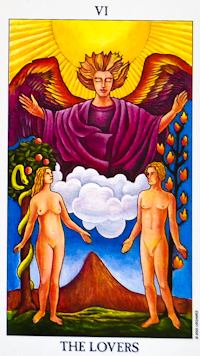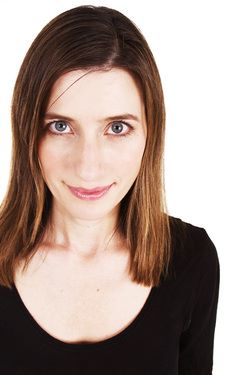What does the Tarot tell us about love?

This is the first of our Love Blogs in a series commissioned by IMMA in association with the exhibition What We Call Love: From Surrealism to Now.
Upcoming articles in the series include Dr Noel Kavanagh A Philosopher’s Perspective on Love; Andrew Hyland on his experience of the Marriage Bill referendum and Dr Rebecca King O’Riain on the Globalization of Love. In this first blog Tarot Maven, Danielle Vierling, on BEING in the LOVERS ETERNAL EMBRACE: How the Archetypal Tool of Tarot Guides Us in LOVE.

The question of what we call love inspires a vast and varied response. I was recently the Tarot Maven at the opening of IMMA’s exhibition What We Call Love: From Surrealism to Now, interestingly, of the 50 or so people who sat in on a reading about love, the questions that arose were far from the usual superficial query about lovers. There was a great willingness among attendees to consciously explore the deeper meaning of love in their lives, both real and desired. The questions ranged from the existential to the ephemeral to the erotic, What is love? and Can love last? to Is it possible to have a polyamorous relationship?
What does the Tarot tell us about love? A zoom-in on the archetypal Lovers card (below) illuminates some esoteric wisdom about the exploration of love in our lives. Many assume that this Trump card means love will be crossing their path and indeed some Tarot decks talk about it as representative of a lover’s quarrel or love triangle. Our tendency here is to hold a romantic or sexual notion attached to finite coupledom. We naively want to hear, “You’re my one and only forever”.

On a deeper level, the archetype of the Lovers is more about the inner masculine (The Tarot Emperor archetype of male power) and inner feminine (The Tarot Empress archetype of female power) energies in oneself rather than about experiencing love with another. Carl Jung, the prominent psychoanalyst who worked with the Tarot, highlighted the Syzygy, or Divine Couple, as an archetype of psychological integration, the union of opposites. When we take on a consciousness of separateness, as in the biblical association with Adam as the pure male form and Eve as the pure female form, featured in classic Tarot such as The Rider-Waite-Smith deck, this leads to the head-wrecking of ‘me vs. you’ which is inherent in the Lovers/Gemini archetype. The truth is, as in the traditional Indian tantric myth of Krishna (divine masculine) & Radha (Divine Feminine), we often attract our polar opposite in an effort to merge our own inner male (animus) and inner female (anima), ultimately becoming one with all of creation.
So what does it mean when the Lovers card appears in a Tarot reading? Superficially, you can expect that one or more lovers may be in your path which draws you into an emotional dilemma about how to integrate the different and sometimes conflicting aspects of the self. Here we are looking at the complexity of your own psyche. If you become critical of what you see in the other, then you must examine what echo or magnification of that quality you may need to change in yourself. We don’t need to confine this mirroring to only heterosexual relationships since no matter our gender or sexual orientation, we can all exemplify both the male qualities of initiative and expressiveness, or the feminine qualities of receptivity and creative gestation. If we are unbalanced within ourselves, we will attract unstable relationships and get that mirror externally from others. If we think someone else will complete us and must be our better half, then our cup of love always stays half empty.
Our relationship with ourselves is paramount for fulfillment in love. If we achieve inner balance of our male energy/yang with our female energy/yin then and only then can we attract and sustain the unconditionally loving and dynamic relationships we wish. Furthermore, we can expand beyond the limitations of a finite vision of love as exclusive and dependent on another and embrace a more compassionate state of being that allows us to experience infinite and eternal love no matter who is present in the path.
On Wednesday 18 November Danielle Vierling will perform Tarot Maven in the exhibition What We Call Love from 6 to 7pm prior to the lecture by Dr Maureen Gaffney, bestselling author of Flourishing at 7pm. Dr Gaffney will discuss her research into the science of emotional intelligence, human functioning and strategies for building fulfilling lives, to offer insights into how we can all benefit from a longer look at love and its various guises in contemporary society. The event is free but booking is essential, book here.
Bio on Tarot Maven, Danielle Vierling
 Given a California family upbringing in professional psychology, astrology, spiritual values, and shamanistic practices, Danielle had great training in the real life application of archetypal tools since her early childhood. During her past 18 years in Ireland, she has developed her thriving professional practice as a Spiritual Tarot Reader, Astrologer, Teacher and Intuitive Development Guide to empower individual needs, growth, and well being in life. Known for her compassionate and non-judgemental approach to her clients and group participants, Danielle has been featured on Irish radio, RTE television, and in several publications including IMAGE magazine, the Sunday Independent, the Evening Herald, and currently as a quarterly contributor to NETWORK magazine.
Given a California family upbringing in professional psychology, astrology, spiritual values, and shamanistic practices, Danielle had great training in the real life application of archetypal tools since her early childhood. During her past 18 years in Ireland, she has developed her thriving professional practice as a Spiritual Tarot Reader, Astrologer, Teacher and Intuitive Development Guide to empower individual needs, growth, and well being in life. Known for her compassionate and non-judgemental approach to her clients and group participants, Danielle has been featured on Irish radio, RTE television, and in several publications including IMAGE magazine, the Sunday Independent, the Evening Herald, and currently as a quarterly contributor to NETWORK magazine.
For further information, please see Danielle’s website.
Read the next article in the Love Blog series; Do I lie when I say I Love You by Dr. Noel Kavanagh>
Categories
Up Next
Introducing new programme: Art | Memory | Place
Wed Oct 21st, 2015